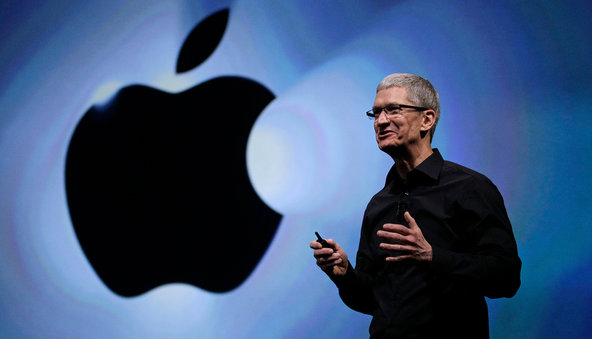 Eric Risberg/Associated Press Timothy D. Cook, Apple’s chief executive, at the introduction of the iPhone 5.
Eric Risberg/Associated Press Timothy D. Cook, Apple’s chief executive, at the introduction of the iPhone 5.
If Apple continues on its current trajectory, something remarkable might happen on April 9, 2015, at around 11 a.m.
That is, statisticians and investors I’ve spoken with say, a conservative estimate of when Apple could become the first company ever to be valued at $1 trillion. (Yes, you read that correctly: the number one, followed by 12 zeros.)
Other analysts are making even more aggressive estimates for the company’s value, which, as of Friday, was $656 billion. Those people put the trillion-dollar mark at less than a year from now: Aug. 16, 2013.
“It’s hard to imagine Apple growing any faster than it has grown on both the release of the iPad and iPhone,” said Michael E. Driscoll, chief executive of Metamarkets, a big data and predictive analytics company, and one of the people betting Apple will top $1 trillion in 2015.
Estimating when, or if, Apple will become the first to be worth $1 trillion is a bit of a parlor game, but we can all likely agree on one fact: today, it is a juggernaut.
Not long ago, Apple was a boutique PC maker. Since then, it has rolled over almost every company in its path, first with music players, then with cellphones and, more recently, with laptops. Nokia, Sony, Research in Motion, Dell and Hewlett-Packard have all watched open-mouthed as Apple took markets they thought were secured. Each time, Apple’s stock rose and their stock fell.
“They are certainly a different kind of company,” said Walter Piecyk, a wireless research analyst at BTIG Research. But, he warned: “So was Nokia in the late ’90s. No one thought they’d ever be challenged, and look at where they are today.”
Even with this growth, there is another possibility: that Apple never reaches $1 trillion. “In a worst-case scenario, Apple could befall the fate of Microsoft, which had a similarly dizzying peak in late 1999,” Mr. Driscoll said. “In this scenario, it will never happen.”
If $1 trillion were the peak of Mount Everest, Microsoft would have been rising through the highest base camp in December 1999, when its market capitalization hit an all-time high of $616.3 billion. Since then, the company has slid down the side of the mountain and is currently valued at a mere $261 billion.
Indeed, the flap over the poor-quality maps on the iPhone 5 has led some people to wonder if Apple has already jumped the shark. But remember how well it has weathered other challenges, like poorly functioning antennas and Siri’s erratic behavior.
Apple is different from Microsoft. “When Microsoft peaked in 2000, it had 20 years running the PC revolution. We’re essentially only five years into the smartphone revolution,” said Charles S. Wallman, a securities analyst who runs an investment group in Middleton, Wis. “Apple has 435 million customers based on the number of credit cards in iTunes. That’s 6 percent of the world’s population. It’s not a stretch to say it can get to 10 or 12 percent of the world’s population.” (Before we go any further, stop and reflect on the power that gives Apple.)
Even if Apple didn’t enter any new product categories, it could reach $1 trillion by doubling its sales. That’s hard for a big company, but in many respects, it is already happening. According to the latest statistics released by I.H.S. iSuppli, a research company, the Apple iPad accounts for nearly 70 percent of the tablet market. BTIG Research predicts Apple will sell 45 million iPhones in the December quarter alone. (During the same quarter last year, the company sold 37 million iPhones, doubling its revenue from a year earlier.)
While it used to be a presence in the United States and a nobody overseas, Apple is now rolling out products like the iPhone 5 worldwide on the same day. The company will also, predictably, continue to increase its global retail division of 388 stores. These stores make an average of $5,647 in sales per square foot. By comparison, shopping malls in the United States make an average of $341 in sales per square foot.
The company will continue to grow in China, too, where many of the more than one billion people who own mobile phones are upgrading to smartphones.
And don’t forget those clunky old PCs. While other computer makers have lost ground, sales of Macs have grown each quarter for the past six years.
And none of these staggering drivers of growth consider Apple entering entirely new markets.
“When we invented the car, it was a substitute for horses, but it was the second phase of the car revolution — when we invent things around the cars like gas stations and drive-ins — that created new business markets,” Mr. Wallman said. “We’re seeing this happen now with the technology we have in our hands. We’re entering the second phase of this revolution, where entirely new markets will be created, and Apple could create those.”
For instance, Apple could transform the television industry, making its own TV set built on iOS, which analysts estimate could bring in another $20 billion a year in revenue. Or it could try to reinvent money itself, turning on the 435 million credit cards it has on file and enabling mobile payments. And there are consumer electronics areas that haven’t even been invented yet, like wearable computing.
When Apple first introduced the iPhone, people slept in the streets to buy one. Five years later, people are still lining the streets to snatch the latest update, even though it is only a slight variation on the one before it. A company that can pull that off, selling two million iPhones in the first 24 hours, might be worth $1 trillion in no time at all.
Article source: http://bits.blogs.nytimes.com/2012/09/23/will-apple-be-the-first-to-break-1-trillion/?partner=rss&emc=rss